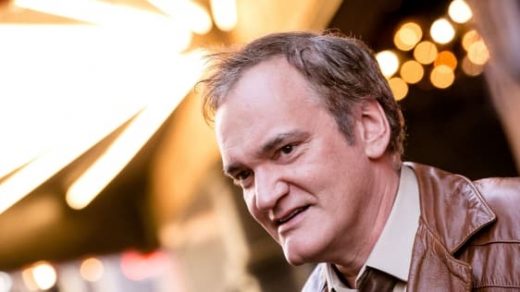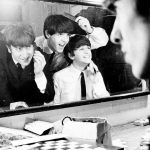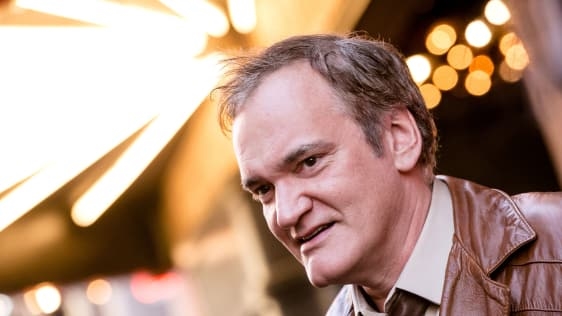Quentin Tarantino Is Not Happy He’s “Taking The Heat” For That Uma Thurman NYT Story
In an interview with Deadline, Quentin Tarantino responded to the recent New York Times story in which Uma Thurman finally fleshed out her much-discussed red carpet comments about being too angry to comment on #MeToo. In her Times interview with Maureen Dowd, the actress alleged that Harvey Weinstein sexually assaulted her. She also talked about her complicated relationship with Quentin Tarantino, who directed her in Pulp Fiction and both Kill Bill movies.
Video footage included with the Dowd story shows Thurman crashing a car on the set of Kill Bill. Thurman says she was forced to drive the car for the scene, even though it allegedly had been deemed unsafe. Though Thurman made clear in an Instagram post following the publication of the Times article that she doesn’t blame Tarantino for the injuries she sustained during the crash, plenty of others in the media and Twitterverse felt he had some explaining to do.
And he did. Tarantino defended himself at length in his Deadline interview—and elaborated on his previously expressed thoughts about not doing more to stop Weinstein’s abusive behavior. Here are the main takeaways:
After more than 15 years, Tarantino gave Thurman the footage of the crash (he calls digging it out of storage a “herculean task”):
I knew that the piece was happening. Uma and I had talked about it, for a long period of time, deciding how she was going to do it. She wanted clarity on what happened in that car crash, after all these years. She asked, could I get her the footage? I had to find it, 15 years later. We had to go through storage facilities, pulling out boxes. Shannon McIntosh found it. I couldn’t believe it. I didn’t think we were going to be able to find it. It was clear and it showed the crash and the aftermath. I was very happy to get it to Uma.
Tarantino was offered an interview with Maureen Dowd as well, but he never followed through:
The thing is, Uma had people she wanted to indict, for that cover-up. Part of my job on the piece was to do an interview with Maureen Dowd, and back up Uma’s claims. And we never hooked up. Me and Dowd never hooked up. I read the article and basically it seemed like all the other guys lawyered up, so they weren’t even allowed to be named. And, through mostly Maureen Dowd’s prose, I ended up taking the hit and taking the heat.
Tarantino takes full blame for the accident, stating the last-minute decisions to switch directions of the driving sequence and not checking to make sure that road was straight resulted in Thurman losing control at the wheel:
That is exactly what happened. I thought, a straight road is a straight road and I didn’t think I needed to run the road again to make sure there wasn’t any difference, going in the opposite direction. Again, that is one of the biggest regrets of my life. As a director, you learn things and sometimes you learn them through horrendous mistakes. That was one of my most horrendous mistakes, that I didn’t take the time to run the road, one more time, just to see what I would see.
Tarantino corroborates Thurman’s account of Weinstein apologizing for assaulting her at his request:
Then, while we were getting ready to do Kill Bill, Uma tells me that he had done the same thing to her. That was when I realized there was a pattern, in Harvey’s luring and pushing attacks. So I made Harvey apologize to Uma. . . . Well, my confrontation was saying, you have to go to Uma. This happened. You have to apologize to her and she has to accept your apology, if we’re going to do Kill Bill together.
. . . I knew she wasn’t lying. There wasn’t another side to this story. There was this story. Harvey was really good at saying, well, the reality is there was this, that or the other thing . . . and frankly, if you don’t know the people who are being talked about, you could give somebody the benefit of the doubt. In this case, I wasn’t giving Harvey the benefit of the doubt.
I knew he was lying, that everything Uma was saying was the truth. When he tried to wriggle out of it, and how things actually happened, I never bought his story. I said, I don’t believe you. I believe her. And if you want to do Kill Bill, you need to make this right.
Tarantino discusses his own complacency with regards to Weinstein:
For some reason that now feels wrong, back in 1999, it was easier to chalk up what he was doing, to this mid-’60s, Mad Men, Bewitched era of an executive chasing the secretary around the desk. Now, it’s like . . . as if that was ever okay! One of the things that has happened in this whole thing is there is a lot of staring in the mirror.
Tarantino says Dowd editorialized the part in her article where she alludes to him spitting on Thurman during a scene in Kill Bill as some form of revenge:
So that’s where it is coming from. We’ve all seen movies where people get spit in the face. I’m assuming if it was a two-shot and Michael Madsen spat in her face, there probably wouldn’t be an issue. But that wasn’t the shot. The shot was, Michael Madsen had snuff juice. And you see him spit out a stream of snuff juice. Cut to Uma’s face, on the ground and you see it hit her.
Naturally, I did it. Who else should do it? A grip? One, I didn’t trust Michael Madsen because, I don’t know where the spit’s going to go, if Michael Madsen does it. I talked to Uma and I said, ‘Look, I’ve got to kind of commit to doing this to you.’ We even had a thing there, we were going to try and do it with a plunger and some water. But if you add snuff juice to water, it didn’t look right. It didn’t look like spit, when it hit her when we tried that. It needed to be that mix of saliva and the brown juice. So I asked Uma. I said, I think I need to do it. I’ll only do it twice, at the most, three times. But I can’t have you laying here, getting spit on, again and again and again, because somebody else is messing it up by missing. It is hard to spit on people, as it turns out.
Same goes for a choking scene:
In the case of the choking, when Gogo [Chiaki Kuryama] throws her chain ball at the bride, and the chain wraps around her neck. And then she’s getting choked by it. Frankly, I wasn’t sure how we were going to shoot that scene. Wrap a chain around the neck, you’ve got to see choking. I was assuming that when we did it, we would have maybe a pole behind Uma that the chain would be wrapped around so it wouldn’t be seen by the camera, at least for the wide shot. But then it was Uma’s suggestion. To just wrap the thing around her neck, and choke her. Not forever, not for a long time. But it’s not going to look right. I can act all strangle-y, but if you want my face to get red and the tears to come to my eye, then you kind of need to choke me.
In her Instagram post, Thurman cites producers Lawrence Bender, E. Bennett Walsh, and Weinstein as the parties responsible for the crash, names that were apparently removed from the New York Times article:
Uma in her Instagram today called out the people she felt were the culprits. Harvey, Lawrence [Bender], and Bennett Walsh. Harvey and Lawrence and Ben lawyered up and they seemed to keep themselves from being named in the piece. Their names were actually redacted from the piece. Whenever Uma said Lawrence, The New York Times redacted it out.
Read Tarantino’s full interview with Deadline here.
Fast Company , Read Full Story
(22)














